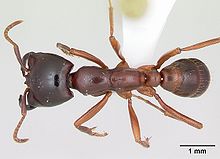
The Formicinae are a subfamily within the Formicidae containing ants of moderate evolutionary development.

Ponerinae, the ponerine ants, is a subfamily of ants in the Poneromorph subfamilies group, with about 1,600 species in 47 extant genera, including Dinoponera gigantea - one of the world's largest species of ant. Mated workers have replaced the queen as the functional egg-layers in several species of ponerine ants. In such queenless species, the reproductive status of workers can only be determined through ovarian dissections.

Myrmicinae is a subfamily of ants, with about 140 extant genera; their distribution is cosmopolitan. The pupae lack cocoons. Some species retain a functional sting. The petioles of Myrmicinae consist of two nodes. The nests are permanent and in soil, rotting wood, under stones, or in trees.

Dolichoderinae is a subfamily of ants, which includes species such as the Argentine ant, the erratic ant, the odorous house ant, and the cone ant. The subfamily presents a great diversity of species throughout the world, distributed in different biogeographic realms, from the Palearctic, Nearctic, Afrotropical region and Malaysia, to the Middle East, Australian, and Neotropical regions.

Leptanilloides is a genus of ants in the subfamily Dorylinae. Leptanilloides is an uncommonly collected genus with subterranean habits in the New World Andean and sub-Andean tropics.

Neivamyrmex is a genus of army ants in the subfamily Dorylinae.

Cerapachys is a genus of ants in the subfamily Dorylinae. Species are mainly myrmecophagous ants which raid the nests of other ants for prey. The genus is distributed widely throughout the Indomalayan region. The genus was revised by BoroWiec (2016) who split a number of previously synonymized genera out of Cerapachys, leaving only 5 species in the genus.

Sphinctomyrmex is a genus of ants in the subfamily Dorylinae. The genus is a tropical and distinctive group, originally described by Mayr based on a single gyne collected in Brazil. Morphologically, the genus is characterized by the unique arrangement of the gastric segments, which are nearly equal in length and separated from each other by distinct constrictions. Very little is known on the natural history of Sphinctomyrmex. The few observations so far suggest that ants of this genus are nomadic predators of other ants. The genus Zasphinctus and approximately 20 species were formerly included, but were split out during revision of the Dorylinae genera by Borowiec (2016).

Zasphinctus is a genus of ants in the subfamily Dorylinae. The genus is a pantropical and distinctive group, originally described by Wheeler (1918) based on "Sphinctomyrmex" turneri collected in Queensland, Australia. Zasphinctus was first described as a subgenus of "Eusphinctus", and then synonymized into Sphinctomyrmex, to later be raised to full genus status by Borowiec (2016), who included approximately 20 species in the new genus circumscription.

Chrysapace is a genus of ants in the subfamily Dorylinae containing four described species. The genus is distributed across the Malaysian peninsula, Indonesia, and the Philippines, with undescribed species from Madagascar and from Baltic amber Chrysapace was described by Crawley (1924) and later placed as a junior synonym of Cerapachys by Brown (1975). Chrysapace was resurrected as a valid genus by Borowiec (2016) during redescription of the doryline genera.

Lioponera is a genus of ants in the subfamily Dorylinae containing approximately 74 described species. The genus is distributed widely across the Afrotropical, Australasia, Indomalaya, Malagasy, and Palearctic bioregions. Lioponera was described by Mayr (1879) and later placed as a junior synonym of Cerapachys by Brown (1975). Lioponera was resurrected as a valid genus by Borowiec (2016) during redescription of the doryline genera.

Ooceraea is a genus of ants in the subfamily Dorylinae containing approximately 16 described species. The genus is distributed across the Australasia, Indomalaya, Malagasy, Neotropical, Oceania, and Palearctic bioregions. Ooceraea was described by Roger (1862) and later placed as a junior synonym of Cerapachys by Brown (1973). Ooceraea was resurrected as a valid genus by Borowiec (2016) during redescription of the doryline genera.

Parasyscia is a genus of ants in the subfamily Dorylinae containing approximately 50 described species. The genus is distributed across the Afrotropical, Australasia, Indomalaya, Malagasy, Oceania, and Palearctic bioregions. Parasyscia was described by Emery (1882), moved to a subgenus of Cerapachys by Forel (1892) and finally placed as a junior synonym of Cerapachys by Kempf (1972). Parasyscia was resurrected as a valid genus by Borowiec (2016) during the redescription of the doryline genera.

Syscia is a genus of ants in the subfamily Dorylinae containing thirty eight described species. The genus is distributed widely across the Eastern Asia, North America, and South America. Syscia was described by Roger (1861), later placed as a Cerapachys subgenus by Wheeler (1902) and then junior synonym of Cerapachys by Kempf (1972). Syscia was resurrected as a valid genus by Borowiec (2016) during redescription of the doryline genera.

Yunodorylus is a genus of ants in the subfamily Dorylinae containing four described species. The genus is distributed widely across mainland Southeast Asia and the island of Borneo. Yunodorylus was described in 2000, later placed as a junior synonym of Cerapachys by Bolton (2003), and was resurrected as a valid genus by Borowiec (2016)

Ponerini is a tribe of Ponerinae ants with 46 genera and 6 extinct genera.

Neocerapachys is a genus of ants in the subfamily Dorylinae containing 2 described species. The genus is distributed across the Neotropical bioregion in central and South America. Neocerapachys was described by Borowiec (2016) during redescription of the doryline genera.















